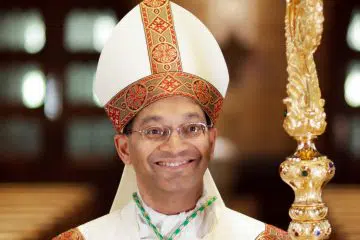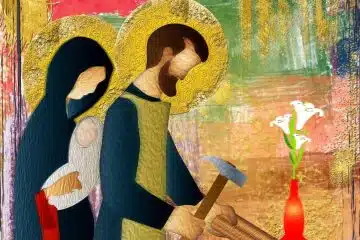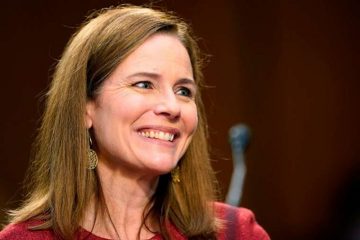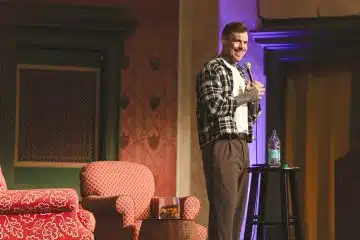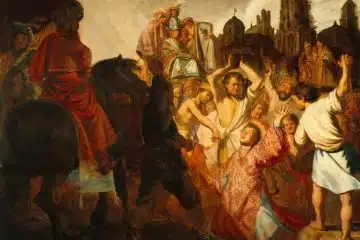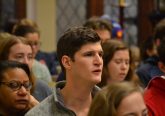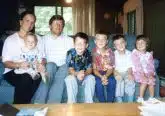‘God was with us on the stairwell’: A hero of 9/11 finds his vocation
Boston, Mass., Sep 11, 2023 / 05:00 am
Paul Carris had started a new job working in the North Tower of the World Trade Center on the 71st floor in July 2001.
Two months later, on the morning of Sept. 11, Carris had just hung up the phone with his manager when a commercial airliner hijacked by al-Qaida terrorists crashed into his building, taking out the 93rd to 99th floors.
Carris survived the trial of that day — and would later be honored for leading a colleague with severe health issues down the 71 flights of stairs to safety before the tower collapsed.
That woman, Judith Toppin, recalling that day, referred to Carris as an “angel.”
But Carris didn’t feel like an angel. In fact, he came to realize after the attacks that despite his lifelong Catholic upbringing, he hadn’t had a real relationship with God.
The trial of that day, and in the years that followed, uncovered a trial of faith for Carris.
But this trial became a blessing for Carris, as it pushed him to discover the beauty of the Catholic faith, the fruit of a relationship with God, and a call to ordained ministry as a deacon in the Catholic Church.
‘Stay calm, and get up’
When the plane hit the North Tower there was a “huge rumbling” sound and the building “tilted” and “wobbled” in place, Carris, 68, told CNA.
He recalled seeing flames, debris, and other objects flying past the windows.
“And that’s when everybody was like, ‘Okay, what the heck just happened?’”
Carris and other members of the staff working at the Port Authority of New York and New Jersey that day thought that a small plane may have hit the building.
When a manager rushed in and told everyone to evacuate the building, Carris, 46 at the time, headed for the stairwell.
But that’s when he saw Judith Toppin, a woman in his division who had severe health problems. She couldn’t get up from her chair as she attempted to slow her heart rate so her defibrillator would not shock her, as it already had.
He remembers seeing a few people surrounding Toppin, 51 at the time, trying to help and went over to her. He told the others to evacuate while he would take care of her. So they did.
In her recollection of the events of that tragic day, Toppin wrote: “It was only then that I looked up into the face of a 6-foot, slender, young man whom I’d never met and what the man said to me was, ‘Stay calm, and get up, we are going to walk out of this building together.’”
Toppin wrote that she had “a bad heart, bad lungs, swollen heavy legs, and the speed of a snail at best.”
Nevertheless, she found the strength to get up and start walking. Carris led her into the stairwell, placed his right hand under her left arm, and the two began the long descent together amid the smell of jet fuel that “permeated the air.”
They stopped to rest on each floor and let others pass because they were taking up the space “railing to railing.”
Carris said that most people don’t realize that people remained calm in the stairwell, adding: “Everybody was helping each other. There was no panic.” People offered Toppin water and firemen who were rushing up the stairwell stopped to offer her an airmask.
They still were not aware of what had happened to the building.
Carris’ only focus was to get Toppin down one step at a time.
“I’ve been asked, ‘What made you stop [to help Toppin]?’” he said, adding, “I guess the Holy Spirit guided me there.”
Finally, when they were about 30 floors from the bottom, a “hurricane”-like wind came up in a blast and hit them.
They would find out later that that wind was the force from the collapse of the second of the Twin Towers.
Soon authorities moved them to another less-congested stairwell. The smell of jet fuel became stronger and they realized “things were not good,” Carris said.
After a grueling hour and a half, with some help at certain points, they finally reached the lobby and saw that it was destroyed.
But they hadn’t escaped the danger yet.
After passing through an obstacle blocking the door, Carris took Toppin, who was heavily leaning on him, up Vesey Street toward the Hudson River and described the surroundings as “just gray.”
The two turned a corner just before the North Tower collapsed, which he described as black smoke and debris coming “like a train.” It missed them by “seconds,” he said.
On that day, 2,752 people were killed in New York City. Another 184 were killed in the attack at the Pentagon, outside Washington, D.C., and 40 died outside Shanksville, Pennsylvania.
‘Life-changing’ event
Following the Sept. 11 attacks, Carris began experiencing issues of anger and rage, the brunt of which was taken out on his family.
Some of that rage was triggered by Toppin’s article in which she called Carris an “angel” sent from God.
“She was describing me as a perfect human being who did all the right things, and it made me reflect on my own life, thinking, well, I haven’t been the perfect human being doing all the right things in my life,” he said.
But the real root of his anger was still unknown to him.
He went to his parish priest, who recommended he see another priest, Father Jim Kelly, OFM, who runs a psychology practice.
Carris’ sessions with Kelly, which went on for nine months, pushed him out of his comfort zone.
He describes it as a “battle.”
Then in the fall of 2002, his parish priest suggested Carris attend a Cursillo weekend, offered by a lay-led movement that offers retreats for a deeper encounter with Christ.
The weekend was filled with silence, a series of talks, the sacraments, and deep prayer. It was on the retreat that the root of Carris’ problems came to a head.
He realized he had been Catholic his whole life but could not remember ever experiencing a relationship with God.
Carris called it a “life-changing” event. It was so effective that Father Kelly told Carris that he no longer needed to see him for therapy anymore.
“It just opened up a thirst for me to want to learn more about my faith. I had never really read religious books or spiritual books,” he said.
He soon found himself stopping in at Catholic bookstores in the city and feeling drawn to certain titles.
One of his first books was the autobiography of St. Teresa of Ávila. Carris then began praying more and took a class run by the archdiocese on Christian ministry run by a religious sister.
“Something in my chest was like, ‘What’s going on?’ She just said things that lit me up inside and wanted me to learn more,” he said.
He began diving deeper into reflecting on the Mass and volunteering with different ministries.
Eventually, Carris said, the diaconate “was almost a natural progression.”
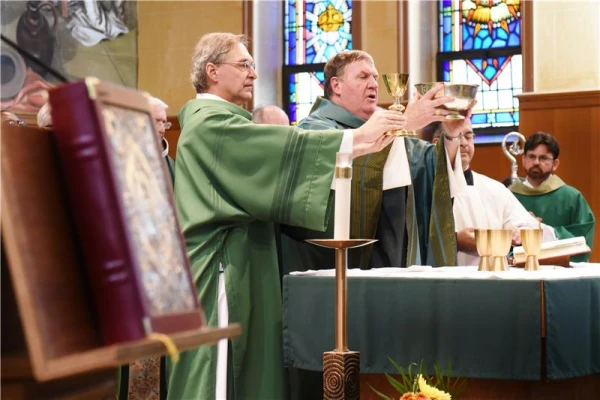
His wife, Carroll, to whom he has now been married for over 40 years, was very supportive of his pursuit of the diaconate. He was ordained in May 2011 for the Archdiocese of Newark, New Jersey.
His favorite part of serving as a deacon is counseling couples engaged to be married.
Carris and Toppin (who died in 2021 at age 72) remained good friends following the events of 9/11.
She even attended his ordination day. When she died, he assisted with a memorial service for her.
Carris said he has already “processed” the events of that day and can now talk about them but still needs to take some silent time after offering interviews.
His heart breaks for those who died that day.
“It was a blessing what happened to me. And that is so difficult to say in an environment where people suffered such tragedy,” he said.
Looking back, he knows that “God was with us on that stairwell that day.”


